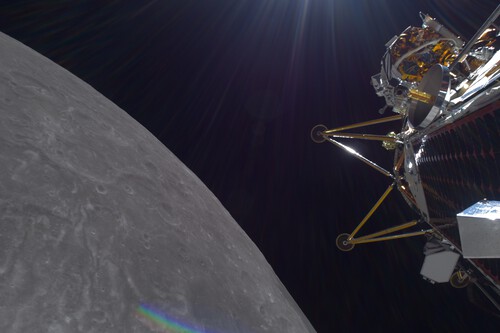“We don’t believe we’re in the correct attitude on the surface of the moon, yet again,” Intuitive Machines CEO Steve Altemus humorously remarked on Thursday at a press conference about the Athena spacecraft’s lunar landing.
Nova-C fell over once again. Intuitive Machines’ Nova-C “Athena” lunar module landed on the Moon on March 6, at 12:30 p.m. ET / 9:00 a.m. PT. The spacecraft is operational, transmits telemetry, and able to receive commands. However, it’s landed in an unfortunate position.
During a week-long journey, the spacecraft completed 39 orbits of the Moon. Additionally, it successfully executed a descent maneuver over the lunar south pole with its methane and liquid oxygen propulsion system. However, something went awry during the landing.
Intuitive Machines is currently uncertain about the exact location and orientation of the spacecraft, but it appears to have landed on its side.
One year later. On Feb. 22, 2024, Intuitive Machines was poised to become the first private company to successfully land on the Moon. However, the Nova-C module “Odysseus” experienced a rough landing, which caused one of its legs to break and ultimately resulted in the module tipping over.
The Athena module faced similar issues due to problems with its laser navigation system. The company is now waiting for NASA’s Lunar Reconnaissance Orbiter to fly over the area to determine Athena’s precise landing location. The NASA robotic spacecraft will also help identify which of its four sides is facing down. For now, engineers suspect that the lander may be resting on a slope.
In power-saving mode. Intuitive Machines has temporarily shut down several subsystems to preserve the probe’s operational life while it investigates the situation. At the lunar south pole, temperatures are extremely low. Depending on the spacecraft’s position and the amount of sunlight it receives, much of its energy may be needed to power the heaters.
Athena was launched to Mons Mouton, a plateau near the lunar south pole, to deploy NASA’s PRIME-1 experiment, which aims to search for water ice in the subsurface. Although part of the scientific mission might proceed, the results are likely to be “off-nominal,” according to Altemus. The Intuitive Machines CEO still considers maintaining contact with the spacecraft a success.
Image | Intuitive Machines
Related | The Lander Athena Has One Primary Mission: Landing Upright on the Moon



